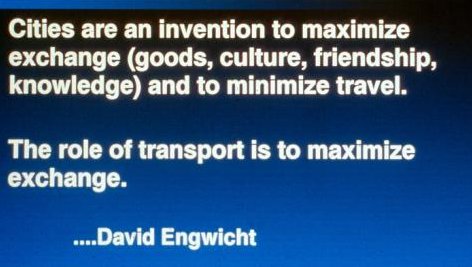Plastics, computer chips, the World Wide Web, and Transportation Demand Management...
Plastics is the big thing of the future in the movie "The Graduate." In the not very good movie, "My Tutor," the young protagonist was told to get into [the] "Computer Chips" [business]. We all know about the continued boom (and occasional bust) that has resulted from the World Wide Web, the graphical and multimedia Internet, and the creation of a global interaction network that William Gibson called cyberspace in the book Neuromancer.
For cities, "transportation demand management" ought to be the next big thing.
DC is resistant. The Office of Planning rejected my proposed amendment to the Comprehensive Plan to require transportation demand management planning. (It's item 24 in this document.)
They said:
The amendment proposal does not correct an error. The current policy provides sufficient guidance to reduce the number of car trips and miles driven to increase the efficiency of the transportation system. Currently, the District does not "require" TDM planning on a neighborhood or district scale. The amendment proposal does not provide information on how this could be achieved. This idea could be discussed/studied by DDOT in conjunction with the Transportation Vision Plan.
YES IT DOES CORRECT AN ERROR. The Comp. Plan says it's important to do something about transportation demand management, but doesn't require that anything be done, with the exception of requiring TDM for planned unit development zoning actions (and as it was, I got that requirement into the Plan).
I should have written a concept paper to show them how to do it. I was about to embark on writing something like that (I was going to set up some meetings with people in Arlington and Montgomery Counties, where they do TDM planning in a variety of ways, and MoCo requires transportation mitigation planning in 4 designed transportation management districts). They should have contacted me, asking for such an additional submission.
It's a pathetic response. I guess they are afraid to have to create a method to do transportation planning instead of mandating automobile-oriented requirements ("parking") in the development review and zoning process. All that you have to do is create a checklist and targets and a system for dealing with it.
I mention this because today's Examiner has a ridiculous example of what it means to not have a city transportaton plan and to not have transportation demand management mandated within it, and to not have a plan for "Parking and Curbside Management" within a transportation plan.
See "D.C. proposes 5 hours of free parking for mourners."
What you have is City Council legislating (or attempting to legislate) piecemeal, poorly thought out "plans" and policies, you don't get anywhere, except for having a bunch of piecemeal poorly thought out policies and practices.
Businesses such as funeral parlors and institutions such as churches should have to perform transportaton demand management planning. Having mitigation plans, which could include providing a limited amount of exceptions from normal parking rules, would provide a systematic way to deal with transportation demand in a manner that promotes optimal mobility, rather than a continued privileging of automobile ownership.
The reason that the Arlington County Master Transportation Plan is "brilliant" is because it is internally consistent. The goals, objectives, and actions of each Element of the Transportation Plan derive from the MTP Goals and Policies, which comprise the Plan's overarching "Framework."
So the goals, objectives, and actions within the Parking and Curb Space Management Element Draft are focused on promoting optimal mobility--because that is the intent of the County's Transportation Plan--not on promoting suboptimal automobile (a/k/a automobile trips especially single occupant vehicle trips).
By way of comparison, DC's transportation planning and land use planning is internally inconsistent.
For those of us who care about quality outcomes, this should be of great concern.
For more on suboptimal automobility see the Robert McCartney column in today's Post on Car-Free Day, "Car-Free Diet Hard to Swallow For Many."
The title of that column is an apt description of the "Long Range Planning" unit of the DC Office of Planning.

Image from a presentation by Dan Burden. David Engwicht is one of the pioneers of the "Living Streets" movement.
Labels: change-innovation-transformation, land use planning, transportation demand management, transportation planning



0 Comments:
Post a Comment
<< Home